
Being a dog parent is a big responsibility. From ensuring they get regular exercise and plenty of love and attention to choosing the right food to keep them healthy, happy and in ideal body shape, there's plenty to think about.
In this article, we'll take you through the dos and don'ts where food is concerned. Explore the different types of food available, learn which foods to avoid and compare our top partnering providers below.
Top sites to buy dog food online
How much food should I feed my dog?
This is possibly the most frequently asked question out there. And, unfortunately, there is no straightforward answer here. How much to feed your dog depends on age, breed, and lifestyle factors too. Learn more about how each of these factors affects how much you should feed your dog below.

Activity
If your pup prefers to lounge on the couch all day, they're naturally going to need less food than one that wants to be up and at 'em from dawn till dusk.

Age
Then, there's age to think about. Puppies are growing doggies. Similar to human children, they'll burn food much faster than adults given that they have seemingly endless energy.
At the opposite end of the scale, we have senior dogs. Seniors are less likely to be as active as younger dogs and additional weight can put added strain on their joints and organs which could lead to more serious health concerns. It would be wise to reduce their calorie consumption in line with their decreased activity levels.

Breed
Finally, let's compare breeds. Typically different breeds fall into different size categories (usually small, medium and large). With each of these size categories comes a different recommended daily calorie intake. For example, a toy poodle definitely wouldn't need the same amount of food as an Australian shepherd.
How much food should I feed my dog summary
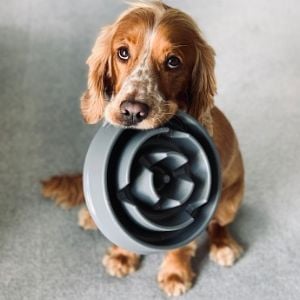 Once you've aligned all the most important factors linked to how much to feed your dog, you'll be better positioned to make an informed decision. That said, if you ever have any doubts, don't hesitate to reach out to your veterinarian. They are trained in everything pet related and will be able to provide you with the expert advice you need.
Once you've aligned all the most important factors linked to how much to feed your dog, you'll be better positioned to make an informed decision. That said, if you ever have any doubts, don't hesitate to reach out to your veterinarian. They are trained in everything pet related and will be able to provide you with the expert advice you need.
In general, it is recommended that dogs eat approximately 2–5% of their body weight in raw food each day. When it comes to dry food, dogs should eat approximately 1/3 of a cup of food per 5kg of their weight each day. So, if your dog is 15kg, you'd be wanting to give them approximately 1 cup of dry food per day.
Puppies tend to consume 2 and even 3 times as much as adult dogs as their food consumption contributes to their growth. Plus they have more energy than their fully grown counterparts.
Different types of dog food
There are so many different types of dog food around that deciding which is right for your doggo can be a bit of a tricky task. Let's explore the different options on offer.
- Wet: Wet dog food is usually sold in cans and is generally a very accessible product. It is available in most grocery stores as well as specialist pet stores and from online retailers. Wet food comes in a variety of meaty flavours and is generally lower in carbohydrates and higher in protein and fat than dry food. It's also a super affordable option for more restrictive budgets.
- Dry: Dry food (or kibble) is one of the most popular dog food solutions around. It's available online in large quantities and is very affordable too. There are loads of brands around and you can change up flavours to keep your pup interested too. The main benefit of dry dog food over wet is the oral hygiene benefits. Dry food keeps your dog's teeth healthy by reducing plaque and tartar buildup.
- Fresh: Fresh dog food is generally made up of human-grade, natural ingredients. It is made up of ingredients like beef, chicken, spinach, carrots and even blueberries. Similarly to humans, a well-balanced diet can do wonders for a dog's well-being.
- Raw: A raw food diet for dogs tends to include uncooked meats, raw eggs and whole or ground bones. Many dog parents opt for this diet as it can lead to a plethora of benefits such as improved joint and bone health, a shinier coat and even reduced body odour. That said, it's important to source raw ingredients from a reputable retailer. Failure to do so could lead to using contaminated food. This could in turn lead to bacterial infections that compromise your dog's health as well as your own.
- Holistic: Holistic food is basically free from animal byproducts, additives, artificial colours and preservatives, and fillers with no nutritional value. Holistic foods are rich in high-quality, nutritious and natural food. They promote all-round health for your four-legged friend and is said to reduce the risk of allergies and skin complaints.
- Homemade: The only thing you need to think about if you've decided to take the homemade approach to feeding your dog is ensuring that all their nutritional needs are met. Balance is key. Like us, dogs need a combination of protein, fibre, carbohydrates and vegetables to promote all-round health.
- Dental: We've all heard the phrase "dog breath" being flung around at some point in our lives. Well, the weight behind the term is one you'll have become well-acquainted with since becoming a dog parent. Poor dental hygiene is the main culprit here. Unlike us, dogs don't brush and floss their teeth twice a day. As a result, plaque and tartar build up which leads to bad breath. Dental dog food works by being gently abrasive during the chewing process. This helps to break down the bacteria and removes excess plaque in between vet teeth cleanings, leaving your pooch with better smelling breath.
- Prescription: Prescription dog foods are generally vet-recommended for pups suffering with allergies, weight loss or gain, organ complaints or bone and joint issues. These are generally available at specialist pet retailers both in-store and online.
- Snacks and treats: Snacks and treats are readily available in a variety of forms. They can be handy to have around for a range of scenarios including training, teething, dental hygiene and to ease separation anxiety. From chews and soft treats to dental sticks, homemade snacks and beyond, treats and snacks for your dog are easy to find at grocery stores, pet specialists and online.
If you're planning on switching your dog's diet, we'd always recommend consulting your veterinarian beforehand. They can give you expert advice that could be relevant to your pet's individual breed, age or nutritional needs.
Want to know more about where to buy dog food online? Check out our guide here.
When to switch a puppy to dog food
The general consensus here is that you should usually wait until your puppy is at least 12 months old before transitioning them to adult dog food. That said, there are longer recommended wait times for this switch in food depending on the size of your dog.
Petbarn recommends transitioning small and medium dog breeds from 12 months onwards. However, for larger breeds it is advised that you should wait until your dog is 18 months old and for giant breeds, the recommended switch from puppy to adult dog food should wait until they are 24 months (2 years) old.
When switching your dog from puppy to adult food, it's important to remember that most breeds have sensitive stomachs. So, if you make the change all at once they're likely to experience some stomach discomfort and a few loose stools during the period of adjustment. As a result, it's recommended that you transition your puppy to its new adult meal plan over a couple of weeks. You can introduce them to their new food by mixing a little into their puppy food, gradually adding a little more each time until the end of a 14-day period.
In the event that your dog suffers from stomach discomfort during the course of the graduated transitions, it is recommended you pause it until your dog's stomach health returns to normal. Then, simply start the transition process from the beginning.
Foods to avoid
As with all pets, there are a number of foods that are a definite no-no for doggos! Check out the list below to learn more about what not to feed your four-legged friend.
- Avocado: Avocado contains persin which is harmless to humans but large amounts can be toxic for dogs.
- Alcohol: It has the same effect on dogs as it does on humans. The problem is it takes much smaller quantities to do serious damage.
- Onions and garlic: Onions and garlic in any form can devastate a dog's red blood cell count leading to anaemia.
- Caffeine: Keep your canine clear of tea, coffee and other caffeinated products. Large quantities can be fatal.
- Grapes and raisins: Grapes and raisins can lead to kidney failure in dogs and even the smallest amount can make them really ill.
- Chocolate: Chocolate contains a toxic agent called theobromine and it's found in every type of chocolate. The most dangerous type of chocolate for dogs is dark chocolate but it's advisable that you keep all chocolate out of reach of your pooch to avoid stomach upset, dehydration and potentially fatal side effects.
- Products containing xylitol: Commonly found in lollies, toothpaste, chewing gum and other household staples, xylitol can cause an increase in insulin. This causes your dog's blood sugar levels to drop and can result in liver failure.
- Macadamia nuts: Macadamia nuts are poisonous for dogs and as few as 6 can cause major health issues, even fatality.
In terms of breed-specific no-nos, there aren't really any. What a particular diet recommendation would come down to is a vet's diagnosis. So, if a dog was diagnosed with high cholesterol and blood fat levels, a vet would recommend low cholesterol and low-fat diet whatever the breed.
Some dogs, like Labradors, are more prone to obesity. That said, whatever the breed, if your dog is diagnosed with obesity or even as overweight, a lower calorie diet would be advisable. As always, if you are at all worried about your dog's health or weight, book a consultation with your vet. They are the experts after all!
How your dog's lifestyle affects diet choices
Metabolic rates, age, activity levels and even the temperature outside can all affect your dog's dietary needs. Read on to learn more.
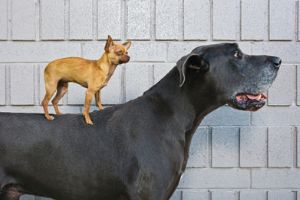
Metabolic rate
Generally speaking, the smaller the breed, the higher its metabolic rate will be. Miniature and toy breeds will need feeding more frequently and a higher digestibility food source. This is most important during periods of rapid growth including puppies and pregnancy.
In contrast, larger breeds and older less-active dogs have substantially lower metabolic rates. Desexed dogs also have lower metabolic rates. Therefore desexed, large breeds and senior dogs generally need less food.

Activity levels and age
In dogs, the rule is generally the same as in humans. The more active your dog is, the more food they will need to consume to restore their energy supplies. The higher the level of activity, the greater the need for protein and fats, but the lower the need for carbohydrates.
At the opposite end of the scale, older dogs (as a general rule) gradually become less active and they will require lower protein and fat levels. In senior dogs, decreased amounts of food is usually the best idea to avoid obesity and all the health issues that come hand in hand with being overweight.

Temperature
During periods of cold weather, dogs with shorter coats will require higher energy levels in their diet. In some instances, dry foods can be sprayed with higher levels of fat during the winter months. The extra fat helps to keep your doggo warm and keeps their energy stores high as they burn energy to maintain their body temperatures.
During periods of hot weather, your dog's demand for energy in their diet decreases. As such, lower fat and protein levels will be required during the height of summer.
What is the best food to feed my dog?
Given we've already learned that what and how much to feed your dog depends on their health, age, activity levels, breed and your personal preference, there is no right or wrong answer here. As long as the food you choose for your dog is nutritionally complete, you can't really go far wrong. Just remember to stick to the recommendations of your veterinarian on quantities to keep your four-legged friend in great shape.
If you want to learn more about the best dog foods available in Australia, check out our best guide.
Why is my dog throwing up undigested food?
When a dog throws up undigested food, it's usually regurgitation. This can be caused by eating too much too fast, or your dog could be suffering from stress. If you have a greedy pup, a good idea would be to feed them smaller amounts more frequently. If you think your dog is suffering from stress, it could be for any number of reasons.
To identify stress in a dog, you need to be familiar with their normal behaviour. Any marked changes in their day-to-day demeanour, such as hunched posture or excessive yawning and licking of their lips, can all indicate stress. If you suspect your dog is suffering from stress, try to identify the stressor in the scenario. Find a quiet place for them to relax away from the chaos. If that doesn't improve their anxiety, there are a number of products you can try to make them feel at ease; however, a vet should be your first port of call.
Travel sickness is also a common trigger of regurgitation. This is seen more in puppies and younger dogs and is to do with their ability to balance while in motion. Once their inner ear has fully developed and your dog reaches adulthood, you should see a marked improvement in travel sickness.
Of course, the reason for your dog's regurgitation or vomiting could be illness. If you're worried or if it happens more than on an odd occasion, make an appointment with your vet to double check there aren't any underlying issues.
How to stop a dog from eating poop
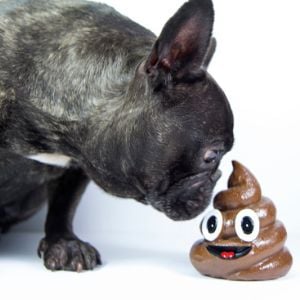 Unfortunately, eating poop is a fairly common behaviour in dogs. However, it is one that you as a dog parent should deter them from doing. Not only is it gross, it could have a negative impact on their overall health.
Unfortunately, eating poop is a fairly common behaviour in dogs. However, it is one that you as a dog parent should deter them from doing. Not only is it gross, it could have a negative impact on their overall health.
Step one is training your pup to have good recall skills. Step two is keeping your garden or yard free from faeces. And, step three is keeping a watchful eye on them and potential outdoor buffets while you're out and about.
When you or your dog spots a poop on the ground, you will need to divert their attention. If your four-legged friend ignores the faeces completely, reward their behaviour with a treat. This will help to impress upon them that eating poop is bad and ignoring it results in a tasty snack. Eventually, the treat-giving process will no longer be necessary and your dog will no longer be interested in eating faeces.
How much is dog food?
As with practically any product on the market, there is a huge disparity in dog food pricing. This means you can spend as little or as much as you like on dog food. That said, you'll want to be on the lookout for a food that is nutritionally complete.
Dry dog food can be sourced for as little as $17.99 for a 3kg bag or $0.60 per 100g. You can also pay up to $180.99 for a 7.98kg bag (approximately $2.26 per 100g).
Wet food is usually sold in individual trays or cans and also varies massively in price. At the lower end of the scale, you can pick up a single tray of wet dog food for $2.09. But, you can also pay up to $7.83 per can.
Fresh, raw and homemade meal plans also differ price-wise. You can expect to pay between $5 and $7 per 250g of raw or fresh dog food depending on which delivery service provider you choose.
Where to get dog food delivery in Melbourne
If you're looking for a dog food delivery service in the Melbourne metro area, here's a list of retailers you can turn to.
- Lyka Pet Food
- Bezzie
- Petzyo
- PetBarn
- Pet House
- Pet Circle
- Lucky Pet Supplies
- My Pet Warehouse
- Amazon
- eBay
Where to get dog food delivery in Sydney
For anyone based in Sydney metro, you can rely on the below stores to deliver delicious doggy meals to your door.
- Lyka Pet Food
- Bezzie
- Petzyo
- PetBarn
- Pet House
- Pet Circle
- Lucky Pet Supplies
- My Pet Warehouse
- Amazon
- eBay
Where to get dog food delivery in Perth
Dog parents in Perth looking for regular food deliveries to their door should compare products at the destinations listed below.
- Lyka Pet Food
- Petzyo
- PetBarn
- Pet House
- Pet Circle
- Lucky Pet Supplies
- My Pet Warehouse
- Amazon
- eBay
Where to get dog food delivery in Brisbane
For Brisbane-dwelling dog families, our favourite dog food delivery options are laid out below.
- Lyka Pet Food
- Bezzie
- Petzyo
- PetBarn
- Pet House
- Pet Circle
- Lucky Pet Supplies
- My Pet Warehouse
- Amazon
- eBay
Where to get dog food delivery in Adelaide
Anyone in Adelaide looking for a dog food delivery service in their area should try these stores first.
- Lyka Pet Food
- Bezzie
- Petzyo
- PetBarn
- Pet House
- Pet Circle
- Lucky Pet Supplies
- My Pet Warehouse
- Amazon
- eBay
Wet food vs dry food
There are actually pros for both wet and dry dog food diets. As a dog parent, it is ultimately up to you to decide which is the better option for your four-legged friend. Let's start by looking at the pros for each food type.
Wet food pros
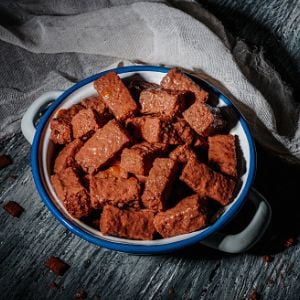 Higher moisture content. As the name suggests, wet food contains moisture. This could be beneficial if your dog doesn't drink as much water as they should. It's also a good choice for any dog with a medical condition that could benefit from proper hydration, e.g. kidney disease.
Higher moisture content. As the name suggests, wet food contains moisture. This could be beneficial if your dog doesn't drink as much water as they should. It's also a good choice for any dog with a medical condition that could benefit from proper hydration, e.g. kidney disease.
Enticing. Wet dog food is generally much more fragrant which tends to result in a more appetising experience when compared to dry food. It could help to tempt poorly or older dogs to eat when otherwise their appetite is decreased.
Meal satisfaction. Wet dog food results in a longer-lasting fullness. Improved levels of that full feeling is extremely handy when it comes to weight management, especially if your doggo is a greedy gus!
Easier to chew. If your dog is suffering with dental disease or other oral health issues, wet food is generally much easier to chew.
Dry food pros
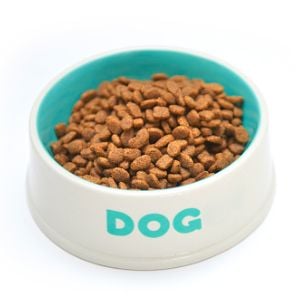 Convenience. Dry diets are easy to pre-portion, won't spoil if left out all day and are readily available at the majority of grocery and pet-specialist stores. If your dog tends to graze all day, dry dog food is an ideal choice. Plus, an open bag of dry dog food will last for months without going off.
Convenience. Dry diets are easy to pre-portion, won't spoil if left out all day and are readily available at the majority of grocery and pet-specialist stores. If your dog tends to graze all day, dry dog food is an ideal choice. Plus, an open bag of dry dog food will last for months without going off.
Promotes better dental health. Dry food has to be chewed. Chewing actually helps to prevent tartar buildup which commonly leads to more serious dental health issues.
Affordable. Granted, pricing varies across different brands. That said, dry food is available in bulk and buying in bulk will often save you substantially long term.
Pairs well with developmental feeders. Dry food is much easier when using a food puzzle or slow feeder. Food puzzles offer cognitive stimulation and slow feeders are great for dogs that tend to eat too quickly which can often lead to regurgitation.
Final thoughts on wet vs dry dog food
 There are different pros for each and as long as you choose food that is nutritionally complete, you can't go far wrong. As a pet parent, you may wish to consider feeding your dog a combination of wet and dry dog food. This could provide the best of both worlds.
There are different pros for each and as long as you choose food that is nutritionally complete, you can't go far wrong. As a pet parent, you may wish to consider feeding your dog a combination of wet and dry dog food. This could provide the best of both worlds.
However, it is crucial that you check you are only giving your dog the correct daily feeding amount. Failure to do so can lead to overfeeding. This can, in turn, result in weight issues.
If you've decided to give your doggo a mixture of both wet and dry food, talk to your vet first. They will be able to accurately calculate the daily calorie requirements for your dog. This will provide you with a baseline and allow you to work out a feeding schedule and quantity combination to avoid any unwanted weight issues down the line.



